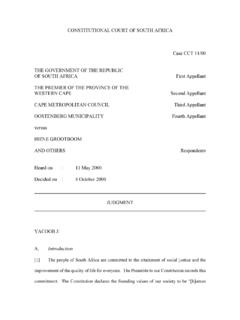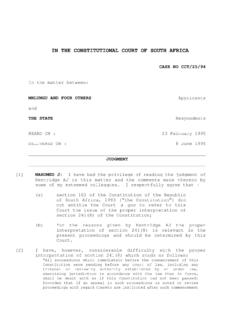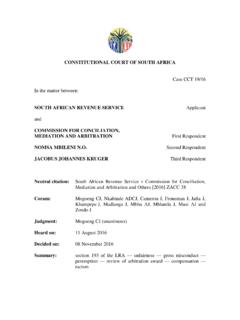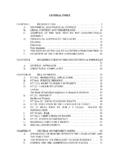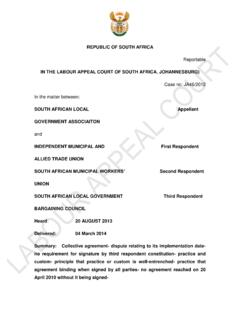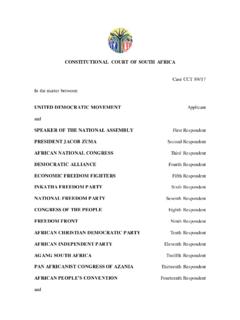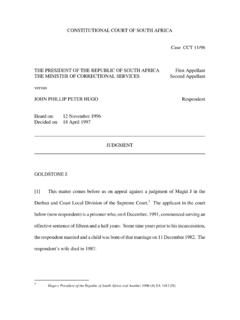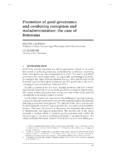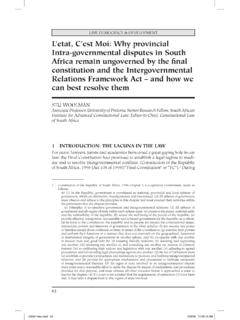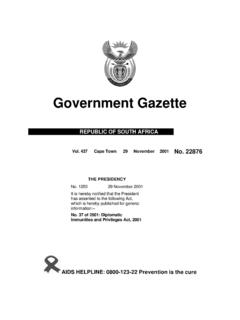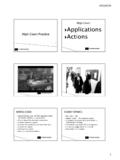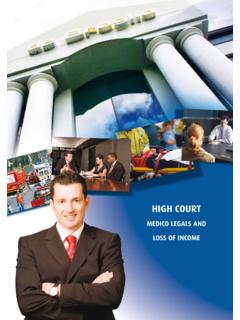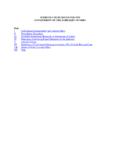Transcription of IN THE HIGH COURT OF SOUTH AFRICA - SAFLII …
1 REPORTABLE THE REPUBLIC OF SOUTH AFRICA IN T HE H IGH CO U RT O F SOU TH AF RIC A WESTE RN C AP E H IGH C OU RT, C AP E TOW N C A S E N O : C C 5 4 / 2 0 1 4 In the matter between: THE S T AT E Versus TER RAN CE S TEP H AN B RO WN Acc used R E A S O N S F O R R U L I N G I N T R I A L W I TH I N A T RI A L M A D E O N 1 7 A U G U S T 2 0 1 5 BOZ ALE K, J: [1] On 17 August 2015, at the conclusion of a trial within a trial, I ruled that certain images found on a mobile phone, Exhibit 1 in the trial ( the phone ), were admissible in evidence and these are the reasons for that ruling.
2 [2] The accused stood trial on two counts of attempted murder, one count of murder and certain ancillary charges, all of which arose out of an incident in 16th Street, Bishop Lavis on the evening of 9 March 2014 when an unsuccessful attempt was made on the life of a gang member. Tragically, a young child was fatally wounded and another bystander shot in the leg in the incident. The State s principal witness identified the accused as the gunman 2 and testified that she observed something drop from his pocket during the shooting. Immediately after the gunman left she returned to the scene and found that it was a phone which she identified as Exhibit 1.
3 Shortly thereafter she gave the phone to Dylan Botha, a member of the criminal gang to which her partner, one Reagan Baptiste, and who had been the target of the original shooting, also belonged. This witness, Ms Joy Cronje ( Cronje ), was unable to state what Botha had done with the mobile phone. In later testimony it emerged that Botha had been shot dead in 2015. [3] The accused pleaded not guilty to the charges and raised an alibi. In the course of his written plea explanation he stated that he had lost his mobile phone on the day prior to the shooting incident.
4 In addition his counsel, Mr Mohamed, put to the various witnesses that the phone placed before COURT , Exhibit 1, was not the accused s. When the prosecutor gave notice that she proposed to lead evidence concerning material which had been downloaded from the phone, Mr Mohamed stated that he objected to the admissibility of the evidence on the following grounds: 1. that the integrity of the chain the evidence of safekeeping of the phone from the time that it was allegedly picked up by Cronje to the time that material was downloaded therefrom, had not been, and could not be, proved; 2.
5 That the evidence sought to be admitted was both hearsay and irrelevant; 3. that such evidence was not covered by the terms of a subpoena issued by a magistrate in relation to the phone in terms of sec 205 of the Criminal Procedure Act, 51 of 1977; 3 4. in any event, any material downloaded from the phone without the authorisation of a magistrate was unlawful and an invasion of privacy. [4] A trial within a trial was held to determine the admissibility of the material sought to be introduced by the State which, at that stage, comprised 5 images or photographs found amongst those stored on the phone.
6 During the course of the enquiry counsel for the State indicated that it sought only to rely on three of the five images and advised that the material was tendered simply with a view to proving that the phone in question was that of the accused or, more accurately, had been in his possession at the time of the shooting. SUMMARY OF THE EVIDENCE IN THE TRIAL WITHIN A TRIAL [5] The state led the evidence of four witnesses, the first of which was Lieutenant Colonel Linnen, the commander of the Co-ordination Centre (also known as the War Room ), a newly created technical division of the SAPS.
7 He testified that his everyday duties involved downloading video surveillance material and data from mobile phones. Such data could include the lists of contacts on a phone, video and photographic images as well as the messages sent or received through the phone using various messaging formats. This he was able to do using a computer software programme available to the police since approximately 2008 and in respect of which he had received training. According to Linnen the programme emanates from Sweden and is widely used by security agencies internationally.
8 4 [6] To effect the downloading from a mobile phone it is simply connected to a laptop containing the software programme which then proceeds to read all the data on the phone and, using the same principle as Bluetooth, downloads it into a file. Linnen testified that the software programme in question did not permit any tampering with the data on a phone, either purposefully or accidentally. Linnen testified that if, for example, he used the phone in question before downloading its contents, this would reflect in the data which is downloaded.
9 In the present case he had deleted nothing from the phone and, even if information was deleted, it could be retrieved. Questioned about the security of the phone whilst it was in the custody of his unit he explained that its integrity was ensured by careful procedures, all of which had been documented. Linnen added that the integrity of the exhibit prior to its reaching his unit was not something over which he had any control nor would he, in the ordinary course, investigate this aspect. [7] Asked about the legal basis for his authority to download material off a mobile phone, Linnen cited the provisions of sec 20 of the Criminal Procedure Act, 51 of 1977 ( the CPA ) and sec 15 of the Electronic Communications and Transactions Act, 25 of 2002 (the ECTA ).
10 He explained that as far as details of the ownership or registration of a mobile phone, including its SIM card, are concerned, these so-called RICA details (an acronym for the Regulation of Interception of Communications and Provision of Communication-Related Information Act, 70 of 2002) could only be obtained from the relevant service provider and not through the software programme his unit used. When, using a standardised form, a mobile phone is presented to him by an investigating 5 officer with a request to download material, he assumes that the device has been lawfully obtained.
